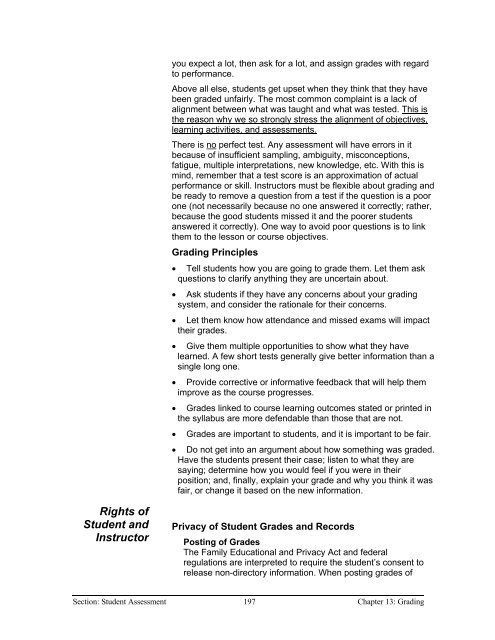Chapter 9 - Instructional Media: Chalkboards to Video - CGISS
Chapter 9 - Instructional Media: Chalkboards to Video - CGISS
Chapter 9 - Instructional Media: Chalkboards to Video - CGISS
Create successful ePaper yourself
Turn your PDF publications into a flip-book with our unique Google optimized e-Paper software.
you expect a lot, then ask for a lot, and assign grades with regard<br />
<strong>to</strong> performance.<br />
Above all else, students get upset when they think that they have<br />
been graded unfairly. The most common complaint is a lack of<br />
alignment between what was taught and what was tested. This is<br />
the reason why we so strongly stress the alignment of objectives,<br />
learning activities, and assessments.<br />
There is no perfect test. Any assessment will have errors in it<br />
because of insufficient sampling, ambiguity, misconceptions,<br />
fatigue, multiple interpretations, new knowledge, etc. With this is<br />
mind, remember that a test score is an approximation of actual<br />
performance or skill. Instruc<strong>to</strong>rs must be flexible about grading and<br />
be ready <strong>to</strong> remove a question from a test if the question is a poor<br />
one (not necessarily because no one answered it correctly; rather,<br />
because the good students missed it and the poorer students<br />
answered it correctly). One way <strong>to</strong> avoid poor questions is <strong>to</strong> link<br />
them <strong>to</strong> the lesson or course objectives.<br />
Grading Principles<br />
• Tell students how you are going <strong>to</strong> grade them. Let them ask<br />
questions <strong>to</strong> clarify anything they are uncertain about.<br />
• Ask students if they have any concerns about your grading<br />
system, and consider the rationale for their concerns.<br />
• Let them know how attendance and missed exams will impact<br />
their grades.<br />
• Give them multiple opportunities <strong>to</strong> show what they have<br />
learned. A few short tests generally give better information than a<br />
single long one.<br />
• Provide corrective or informative feedback that will help them<br />
improve as the course progresses.<br />
• Grades linked <strong>to</strong> course learning outcomes stated or printed in<br />
the syllabus are more defendable than those that are not.<br />
• Grades are important <strong>to</strong> students, and it is important <strong>to</strong> be fair.<br />
• Do not get in<strong>to</strong> an argument about how something was graded.<br />
Have the students present their case; listen <strong>to</strong> what they are<br />
saying; determine how you would feel if you were in their<br />
position; and, finally, explain your grade and why you think it was<br />
fair, or change it based on the new information.<br />
Rights of<br />
Student and<br />
Instruc<strong>to</strong>r<br />
Privacy of Student Grades and Records<br />
Posting of Grades<br />
The Family Educational and Privacy Act and federal<br />
regulations are interpreted <strong>to</strong> require the student’s consent <strong>to</strong><br />
release non-direc<strong>to</strong>ry information. When posting grades of<br />
Section: Student Assessment 197 <strong>Chapter</strong> 13: Grading
















